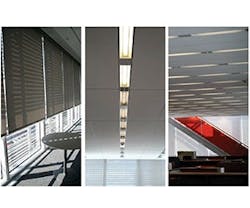Times Building Heralds Steep Savings
A notable Midtown Manhattan building offers a comfortable, yet affordable environment to produce all the news that’s fit to print.
Lawrence Berkeley National Laboratory’s five-year occupancy report on the New York Times Company’s headquarters building shows big savings as a result of the structure’s integrated energy efficiency measures. The 52-story Times Building, the product of extensive collaboration between the Times Company and Berkeley Lab, has achieved a 51% reduction in heating energy use and a 24% reduction in annual electricity use compared to a hypothetical building meeting ASHRAE 90.1-2001 (the current version of code when the building was constructed).
The Times Building was a new construction project occupied in 2007. Nevertheless, the structure offers a slate of lessons for existing buildings in terms of energy retrofit ideas.
Strong Lighting Control
To keep costs down from the start, the Times asked its architectural and engineering teams to design building systems that minimized installation labor, a significant cost in New York City. The fixtures could integrate wire and cabling and came with lamps and ballasts already in place.
The final system incorporated automated dimmable lighting, zoning, and highly efficient hardware, including two-lamp T5 fixtures and electronic, digital-addressable dimming ballasts, with the latter a still relatively new technology when it was chosen (pre-construction development started in 2004). It met the maximum installed lighting power density required by the then-current version of ASHRAE 90.1, 1.3 watts per square foot, with the intent to use dimming strategies to consume less.
Five years later, energy savings on the three floors monitored for the study exceeded expectations. The perimeter zone open-plan work areas used occupancy sensing, setpoint tuning, and daylighting to shave 56% off the ASHRAE standard, which only mandates scheduled lighting controls. Peak demand due to the electric lighting was 30-41% lower than mandated the entire year, according to the study findings.
This resulted in an internal rate of return of 17% and a simple payback of 5.7 years, not counting the time-of-use rate schedule negotiated with local utility Consolidated Edison.
Wise Window Improvements
The Times Company specified automated shades that would do more than just block light from entering. The system they ultimately installed included several innovative features:
Fabric: The twill weave roller shade is two-sided, with a darker gray face positioned toward the outdoors for aesthetics and a white face that brightens the interior when it’s lowered. Reversing the shade would provide better control of solar heat gain and glare, but the system as is still cuts down on glare and solar radiation when lowered.
Motors: Each motor controls multiple shades, usually adjacent to each other. This allows more personal control over individual shades but reduces capital costs and improves the facade’s uniformity by assigning more than one shade to each motor.
Control: The automated shading system operates on a time delay that recognizes when direct sun and glare control are in effect, minimizes unnecessary shade movement, intercepts direct sunlight penetration, and raises the shades if other buildings cast shadows across the windows.
The occupancy evaluation showed employees on the studied floors barely touched the shades’ manual override function, opting to change the shades just 12 times a year on average. Researchers couldn’t separate lighting and HVAC energy savings attributable only to the shading due to energy modeling and benchmarking difficulties, but a simple analysis assuming partial credit for only the lighting energy savings showed an 18% rate of return and a simple payback of 5.4 years using time-of-use rates.
The Times Building also incorporates underfloor air distribution in the lower occupied zone, which saves HVAC energy and contributed to the lower-than-code energy consumption. To read more about the savings in the Times Building, visit buildings.lbl.gov.
